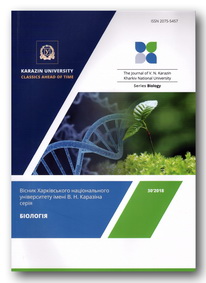Association of Balantidium coli and intestinal coccidia (Eimeria, Cryptosporidium, Isospora) in domestic pigs in Azerbaijan
Abstract
The purpose of our work is to determine the prevalence of associative infections of domestic pigs in the farms of Azerbaijan. The research was conducted in 2009–2015. The faeces samples were taken from 2272 domestic pigs of different ages kept in private farms in the districts of Balaken, Zagatala, Shamakhi, Ismayilli, Guba, Khachmaz, Khudat, Salyan and Absheron peninsula in Azerbaijan, in the region of the Great Caucasus. Species composition, infection intensity, and ecological features of the pig parasitic protozoans had not been studied prior to our research. In the course of our study, the associative invasions in domestic pigs were as follows: Eimeria and Isospora oocysts were found in 582 pigs (25.6 % out of the total animals examined), Eimeria and Cryptosporidium oocysts in 622 pigs (27.4 %), Eimeria oocysts with Balantidium cysts in 273 pigs (12.0 %), Isospora and Balantidium oocysts in 18 pigs (0.8 %), Eimeria, Isospora and Cryptosporidium oocysts were detected in mixed form from one pig only (0.04 %). None of the analysed faecal samples contained a four-component mixed parasitic invasion. The two-component mixed infestations, viz. Eimeriosis + Cryptosporidiosis and Eimeriosis + Isosporiasis, were recorded during the whole year, while the prevalence of Eimeriosis + Balantidiosis and Isosporiasis + Balantidiosis mixed infestations decreased in summer. Keeping pigs of different ages in one pen at the farms increases the risk of associative invasion. In the pig farms equipped with various technological devices, the epizootic situation is different. If the animals kept traditionally, the infestation with associative invasions is much higher. Among the animals that live in unventilated pens with a wooden floor, the intensity of mixed infestation is the highest that results in the extremely high economic loss in such farms. In the animals kept in warm pens with high humidity, the invasion intensity is high even in winter. The primary reasons of this phenomenon are heat and humidity that create favourable conditions for the exogenous development of coccidian oocysts.
Downloads
References
Anisimova M.A. (2013). Mixed infestation of pigs (features of epizootology, complex treatment and prophylactic measures). Materials of the scientific conference "Theory and Practice of the Control of Parasitic Diseases". Moscow. Issue 14. P. 23–26. (in Russian)
Gaibova G.D., Iskenderova N.G., Hajiyeva N.A. et al. (2011). Intestinal coccidians of cattle in the Balakan-Sheki region of Azerbaijan. Actual problems of parasitology in Georgia. Tbilisi. P. 84–88. (in Russian)
Gasanova J.V. (2012). Parasitic protozoa (Protozoa, Apicomplexa) of poultry in Absheron. Thesis for the Degree of Candidate of Biological Sciences. Baku. P. 78–80. (in Russian)
Gavrilova N.A., Petrova M.S. (2015). Mixed infestation of pigs in industrial farms. Materials of the II International Veterinary Congress “International VET Istanbul Group Congress”. St. Petersburg. P. 333–334. (in Russian)
Henriksen S.A., Pohlenz J.F. (1981). Staining of cryptosporidia by a modified Ziehl-Neelsen technique. Acta veterinaria Scandinavica, 22(3–4), 594–596.
Iskenderova N.G. (2007). Emeriid coccidians (Sporozoa, Apicomplexa) of farm animals in Azerbaijan. Proceedings of Azerbaijan National Academy of Sciences (Biological and Medical Sciences), 2, 81–91. (in Russian)
Kulikova O.L. (2010). Mono- and mixed parasitoses of animals in the Middle and Lower Volga region and their biological hazard (epizootological monitoring and control measures). Abstract of the thesis for the Degree of the Doctor of Vet. Sciences. Nizhny Novgorod. 51 p. (in Russian)
Lakin G.F. (1990). Biometry. Moscow: Vysshaya Shkola. P. 178–182. (in Russian)
Maikai B.V., Umoh J.U., Kwaga J.K. et al. (2009). Prevalence and risk factors associated with faecal shedding of Cryptosporidium oocysts in piglets, Kaduna. Nigeria Journal of Parasitology and Vector Biology, 1(1), 1–4.
Mhoma J.R.L., Kanyari P.W.N., Kagira J.M. (2011). The prevalence of gastro-intestinal parasites in goats in urban and periurban areas of Mwanza City, Tanzania. Sci. Parazitol., 12(4), 191–196.
Musaev M.A., Alieva F.K., Abidova H.S., Borovskikh D.R. (1985). Coccidia (Apicomplexa: Eimeridae, Sarcocystidae) of pigs in Azerbaijan. Proceedings of the Transcaucasian Conference on Parasitology (12–14 June 1984). Tbilisi, Metzniereba. P. 69–70. (in Russian)
Ponomarev N.M., Tikhaya N.V., Ponomarev A.N. (2011). Epizootology of mixed infestation of pigs in the farms of the Altai Territory. Bulletin of the Altai State Agrarian University, 7(81), 71–75. (in Russian)
Safiullin R.T., Basynin S.E. (2008). Monitoring of the epizootic situation of the most common pig parasitic diseases in farms of various types by zones of the country. Materials of reports of the scientific conference "Theory and Practice of the Control of Parasitic Diseases", Moscow. P. 411–415. (in Russian)
Yengashev S.V., Daugalieva E.H., Novak M.D., Anisimova M.A. (2014). Methodical guidelines for treatment and prevention of mixed infections in pigs in commercial, individual and husbandry farms. Russian Journal of Parasitology, 2, 121–125. (in Russian)
Authors retain copyright of their work and grant the journal the right of its first publication under the terms of the Creative Commons Attribution License 4.0 International (CC BY 4.0), that allows others to share the work with an acknowledgement of the work's authorship.




